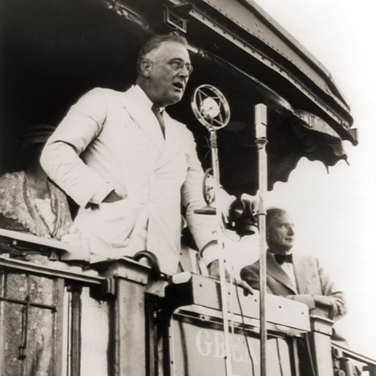News
Lecture examines perception
of disability in society

President Franklin D. Roosevelt addresses a crowd from the observation platform of his train during a stop in Fort Peck, Mont., in 1944. Photo: LIBRARY OF CONGRESS
Even as he grappled with the effects of polio from age 39 to the end of his life, it’s an open question whether Franklin Delano Roosevelt was truly disabled, historian and disability studies scholar Michael Rembis told an attentive audience in Davis Hall yesterday. More than 80 people gathered for the sixth installment in the UBThisSummer lecture series entitled “Exploring UB’s Engagement in Health and Wellness.”
Rembis, associate director of UB’s Center for Disability Studies and an adjunct professor in the Department of History, used the example of FDR’s health to explore larger questions of how disabilities are perceived in our society. He also described how the disability rights movement has grown from a concentration on improved living environments to one that empowers disabled individuals to live their lives fully.
He also outlined the development of disability scholarship, a relatively new academic endeavor that calls into question commonly accepted notions of what it is to be disabled and what wellness might mean for the individual whose health is viewed negatively.
Rembis traced FDR’s strenuous campaigning for New York governor in 1928 and in the first of his presidential elections in 1932. Following his diagnosis of polio in 1921, he spent seven years undergoing a range of treatments. His mother, Sara Roosevelt, hoped he would remain at the family’s home in Hyde Park, N.Y., where he could live comfortably as a country squire. But others, including his wife Eleanor, urged him on to a vigorous political life.
When Al Smith, the unsuccessful Democratic candidate for president in 1928, voiced his support for Roosevelt’s gubernatorial cause, “the Republican press had a field day” criticizing efforts to push FDR into political life in defiance of his doctor’s orders and perhaps threatening his life, Rembis said. But Smith famously retorted that notwithstanding FDR’s polio, a governor need not be “an acrobat. We do not elect him for his ability to do a double-back flip or a handspring. The work of the governorship is brainwork.”
Rembis said FDR’s health and stamina were never issues in his campaigning and subsequent presidency. Rather, what made life challenging for him were the logistics of his getting from place to place. He could not stand without assistance and he was obliged to wear heavy leg braces.
“Everything was new or an experiment,” Rembis said. For instance, a special steel bar was installed on his campaign train and he had to be carried when on stairs or navigating tight spaces. After FDR was elected New York governor in 1928 by a razor-thin margin, he was greeted by a horde of reporters who surrounded his car. No doubt flashing his famous grin, FDR requested “no movies of me getting out of the machine, boys.” The press of that day dutifully cooperated with “this splendid deception,” Rembis recounted.
While a distinctive disability rights movement has been active in the U.S. for more than 100 years, scholars generally agree that a broader movement emerged in the 1960s and 1970s coincident with the U.S. civil rights movement. Enactment of the Americans with Disabilities Act (ADA) in 1990 was a key step forward, Rembis said. But over the years it was weakened by court decisions that gradually narrowed the definition of who might be considered disabled, thus making it almost impossible to file successful discrimination lawsuits. To counter these effects, Congress enacted the ADA Amendments Act of 2008, Rembis pointed out.
“There has been a fundamental rearticulation of what it means to be disabled,” along with an expansion of the “socio-political model” to include a broad range of impairments, including mental illness, learning and developmental disabilities and chronic illness, Rembis said. Ideas about disabled people often are tied to historic, cultural, political and socio-economic considerations, and “they change over time,” he noted.
By questioning attitudes that see disabled persons as “tragic” or “victims,” or solely as “patients” or “clients” within the helping professions, one might now respond differently to FDR’s physical limitations, Rembis said. Instead of viewing people like FDR as “heroes” for surmounting their physical circumstances, far better to see them as “living their lives—and lives worth living.”
During a question-and-answer session, Rembis said the disability rights movement now is concentrating more on inclusiveness rather than mere “tolerance” for those with a disability. And it’s focusing on housing that is accessible for all, rather than simply “accommodating” the needs of disabled individuals.
Finally, answering his own rhetorical question about FDR that framed the lecture, Rembis said the nation’s 32nd president was “impaired but he was not disabled.”
Two lectures remain in the UBThisSummer series, on July 25 and Aug. 1. For details visit the UBThisSummer website .


Reader Comments